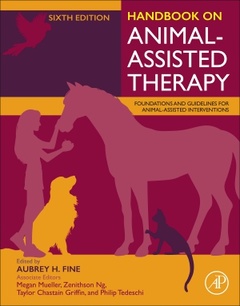Handbook on Animal-Assisted Therapy (6th Ed.)

The field of Animal Assisted Intervention continues to grow, with use for treating additional disorders, patient populations, in different treatment settings, and with different animals. The Handbook on Animal-Assisted Therapy continues to be the leading textbook and reference in this field for clinical practitioners. It provides the evidence basis for the effectiveness of this treatment, as well as guidelines for how to perform it, from the selection of treatment animal to application with patients. This new 6th edition is fully updated and contains 15 new chapters on culture, research, standards, of practice, and more. Organized into four sections, the book explores the conceptualization of the animal-human bond, best practices for AAI professionals, considerations related to animal selection/ training/ welfare, and utilizing AAI in special populations. The book may serve as a study guide for the Animal Assisted Intervention Specialist Certification Exam.
Section One: The Conceptualization of the Animal-Human Bond: The Foundation for Understanding AAI 1. Understanding our Kinship with Animals: Input for Health Care Professionals Interested in the Human-Animal Bond 2. AAI in Historical Perspectives 3. Conceptualizing AAIs: Honoring our past, understanding our present and building a new future for the field of AAI 4. Understanding the Influence of Culture, Race, Ethnicity, and Identity on Animal-Assisted Interventions 5. The Animal-Human Bond: Health and Wellness 6. The State of Research in AAI Section Two: Best Practices for AAI Professionals 7. Professional Competencies and Standards of Practice in AAI 8. Incorporating AAI into Psychotherapy: Guidelines and Suggestions for Therapists 9. Application of AAI in Professional Mental Health Settings: An overview of practice considerations 10. The Application of Animal Assisted Interventions in Various Allied Health Professions Section Three: Considerations Related to Animal Selection, Training, and Welfare 11. What’s love got to do with it? Selecting animals for AA mental health interventions 12. Getting the Right Dog for the Right Job for AAI. Essential Understanding of Dog Behavior and Ethology 13. The role of the Equine in AAI 14. Preparing a Canine for Therapy Dog Work through Training and Relationship-Building 15. Trends in animal welfare research in animal-assisted interventions 16. Our Ethical and Moral Responsibility: Strategies for Ensuring the Welfare of Therapy Animals: 17. Species Specific Welfare Considerations for animals involved in AAI 18. Zoonoses in animal-assisted interventions Section Four: AAI in Special Populations 19. Animals in the Lives of Children 20. Animals in Educational Settings: Research and Practice. 21. The role of Animals for Individuals with Executive Functioning Disorders 22. Companion Animals in Older Adulthood: Engaging and Sustaining the Bond 23. AAI in Special Settings: Hospitals, Colleges, & Correctional Facilities 24. Understanding the Role of Human-Animal Interaction in the Family Context 25. Treating human trauma and depression with the help of animals: Trauma-informed intervention for child maltreatment, adult post-traumatic stress, and depression 26. The Complete Journey: Navigating the Death, Dying & Grief of a Therapy Animal Partner 27. Animal-assisted interventions for military families: A synthesis of the current evidence 28 (Updated and with a few new snapshots) Global Snapshots of Therapy Animal Programs 29. Final Thoughts: The Editors’ Reflections on the State of AAI: The Unknown Future 30. A Personal Tribute to Animals in Our Lives and the Field of Animal Assisted Interventions: Oh the Places We Have Gone and Will Go!
Dr. Megan K. Mueller, Ph.D. is an Associate Professor of Human-Animal interaction at the Cummings School of Veterinary Medicine at Tufts University within the Center for Animals and Public Policy. Dr. Mueller is Co-Director of the Tufts Initiative for Human-Animal Interaction and is a senior fellow at the Jonathan M. Tisch College of Civic Life at Tufts University. Dr. Mueller is a developmental psychologist, and her research program focuses on assessing the dynamic relationships between people and animals in families and communities. Her work focuses on the psychology of the human-animal bond, and how human-animal interaction can promote thriving for adolescents and their families. Her research has been published in numerous scientific journals and media outlets. Dr. Mueller is a board member of the International Society for Anthrozoology and serves on the Pet Partners Human-Animal Bond Advisory Board.
Dr. Zenithson Ng is a clinical associate professor at the University of Tennessee. He earned his undergraduate degree in animal science from Rutgers University and his veterinary degree from Cornell University; then completed a small animal rotating internship at the ASPCA in NYC, followed by a canine/feline primary care residency combined with a master’s degree in human-animal bond studies at Virginia Tech. His clinical interests include small animal behavior, dentistry, preventive medicine, and management of
- Summarizes current research on AAT
- Guides readers how to work with a therapy animal safely and effectively
- Covers AAT with special populations and for specific disorders
- Supports study for the Animal-Assisted Intervention Specialist Certification exam
- Contains 15 new chapters on culture, research, standards of practice and more
Date de parution : 09-2024
Ouvrage de 550 p.
21.4x27.6 cm



